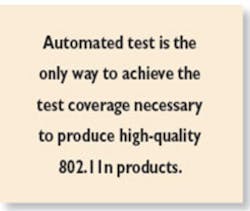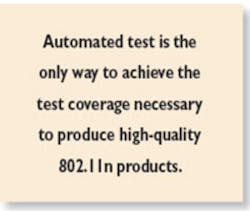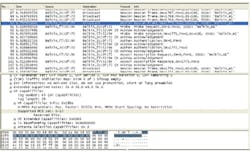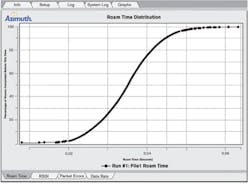Multiple-input multiple-output (MIMO) technology, the heart of the upcoming IEEE 802.11n standard, is the foundation for the next generation of Wi-Fi products. With the promise of greater throughput and range capabilities, 802.11n will enable new voice, video, and data applications that demand greater performance.
It will be up to manufacturers to ensure that their MIMO products deliver the robust interoperability, performance, and quality of service required by these new applications. For that reason, proper test and measurement of device and network capabilities are critical to ensure the success of this growing market.
802.11n Test Challenges and Solutions
802.11n, with the presence of multiple transmit (Tx) and receive (Rx) chains, significantly increases the complexity of the physical (PHY) layer over the 802.11a/b/g standards supporting a much simpler single-input single-output (SISO) architecture. For example, in 802.11n, there are more than 300 modulation coding schemes (MCS), which are functions of channel bandwidth, number of spatial streams, and types of modulations. In contrast, 802.11g has 16 different data rates. The complexity of the 802.11n media access control (MAC) layer also has increased substantially compared to that of 802.11a/b/g technologies. Ensuring that the complex MAC and PHY layers operate properly in an 802.11n system requires thorough functional testing of device-to-device and device-to-network configurations.
For real-world deployment, delivering robust interoperability between 802.11n MIMO and legacy 802.11a/b/g SISO devices is critical to maintaining the success of the Wi-Fi market. Manufacturers are designing MIMO devices to address varying performance requirements.
Devices can be tuned under different environmental conditions to provide maximum throughput, maximum range, or a compromise between the two. This consideration of environmental variability, which does not exist in development of SISO products, adds tremendous complexity to the development and testing of MIMO devices. For that reason, thorough characterization of MIMO devices in a variety of environments is required to verify that their performance adequately meets market requirements.
Functional device-to-device testing and device-to-network testing in a controlled static channel environment provide the necessary conditions for rapid development and troubleshooting of layers 2 and 3 of an 802.11n system. This testing is required to verify the functionality, conformance, and interoperability of 802.11n devices and networks that are independent of layer 1 influences. Examples are basic association handshakes and security negotiations.
Functional testing includes the measurement of higher-level performance parameters that also are not dependant on RF channel characteristics. One example of functional performance testing is the measurement of system throughput with different data-encryption types.
While functional performance testing does not provide a complete characterization of real-world performance, it is a critical step to verifying proper system operation. Measuring the real-world performance of MIMO systems in multipath and fading environments requires dynamic channel emulation using a purpose-built channel emulator.
Functional testing validates operation, conformance, and interoperability of MIMO devices; dynamic channel emulation addresses the performance. The conduct of both test methodologies is required to verify that 802.11n devices function properly, provide robust interoperability, and deliver the performance necessary to satisfy consumer demands.
Functional MIMO Testing
Functional testing of MIMO-enabled devices provides an accurate assessment of hardware and software functionality, standards conformance, and interoperability between MIMO and SISO devices as well as basic operation of MIMO performance algorithms. It involves four critical components:
� Protocol Testing: Verifies that device operation conforms to standard specifications across communications states. This type of testing requires extensive packet capture, filter, and 802.11n decode analysis capabilities.
� Interoperability Testing: Verifies that access points (APs) and client devices designed by different manufacturers supporting next-generation 802.11n as well as legacy 802.11a/b/g technologies work well together.
� Mobility Testing: Verifies operation of 802.11n client devices in mobile operating conditions. Examples of such tests include throughput vs. range and AP-to-AP roaming.
� Application-Level Feature Testing: Verifies that the device delivers a quality user experience. Test examples would be basic data throughput and voice call quality measurement.
Effective functional testing of MIMO devices is conducted in an RF-controlled, static channel environment, ensured by placing DUTs in enclosures that isolate them from unwanted RF interference. Between the enclosures, RF cables connect all the Tx and Rx ports of the devices. A static channel simulator can be used in the RF path to create a stable environment in which the channel maintains consistent output power and undergoes limited to no fading.
While a static channel is not the best representation of a real-world environment where the channel conditions are constantly changing, it provides a basic test environment to focus on the complexity of the 802.11n MAC and protocol layers. Testing devices in the simplified and stable RF conditions provided by a static channel allows engineers to concentrate on features and functions that are not affected by environmental variability.
Abnormalities in device behavior revealed through testing in a static channel environment can be attributed directly to the operation of the device itself and not to the ever-changing environmental conditions. Since these abnormalities are not impacted by RF channel conditions, identifying and diagnosing them are greatly simplified.
Contrasting Approaches to Testing
Two common approaches to functional MIMO testing are do-it-yourself and standardized automated.
Do-it-Yourself Testing
Many do-it-yourself (DIY) test solutions are conducted over-the-air since they provide the quickest way to start testing. While these basic solutions may be low cost, the value of testing also is low because testing in an uncontrolled RF environment produces inaccurate results that cannot be repeated.
More advanced DIY test solutions will do conducted testing. They involve the design and implementation of custom test setups using disparate hardware and software components including RF attenuators, switches, and packet capture. However, the increased complexity of DIY solutions that connect to and use a properly controlled RF environment significantly increases installation and support costs.
Since the expertise of Wi-Fi device manufacturers is in the development of products and not necessarily in the testing of them, DIY solutions often start as ad hoc tests. As such, the solutions are not architected to provide the scalability necessary to cost-effectively evolve from basic to advanced setups capable of extensive functional testing of future products and services. So while the initial expenditure of DIY test setups may be low, the cost of a robust test setup will quickly exceed that of standard, automated test platforms when hardware expenses and engineering resources are accurately accounted for.
DIY methods often rely on manual test execution since management and automation software that controls nonstandard test components from multiple vendors generally is not commercially available. Furthermore, such software would be very difficult and costly to develop in-house.
In the development of 802.11a/b/g products, conducting thorough functional test coverage using manual DIY setups dramatically increases the time to develop a quality product. The large increase in the operational and performance complexity of 802.11n devices has significantly increased the number and complexity of functional tests required to verify the proper operation of 802.11n systems.
In addition, DIY setups lack standard test data management and instead must rely on custom data capture and analysis tools. These tools often don�t have the detailed information analysis capabilities required for robust problem identification and debug, which reduce the effectiveness of internal engineering efforts.
As the complexity in the functionality of wireless devices and networks continues to increase, development and testing using DIY test methods are not scalable in terms of both time and money.
Standardized, Automated Testing
Standard test platforms are purpose-built to offer functional test capabilities at lower cost and complexity than alternative DIY solutions. Effective standardized test platforms will integrate seamlessly with RF isolation chambers to ensure that accurate and repeatable test results are produced.
The use of test automation and standard performance test scripts significantly reduces the time required to test 802.11n devices. Furthermore, with the increased functional and performance complexity of 802.11n devices, automated test is the only way to achieve the test coverage necessary to produce high-quality 802.11n products.
What You Can Learn
A core test of an 802.11n network is the analysis of an association process between an 802.11n AP and an 802.11n station (STA). A packet capture of the association process is used to verify that the high-throughput (HT) capabilities parameters are set correctly on the AP or STA. A functional test would involve:
1. Initiating an 802.11n packet capture prior to beginning AP and STA association.
2. Initiating AP and STA association.
3. Comparing the trace file generated through step 2 and parsing it against the required filter string to check for the existence of the HT capabilities parameters.
Figure 1 presents a packet capture trace from an 802.11n association process.
Click here to see larger image
During an association process of Wi-Fi devices, their capabilities are negotiated between the AP and STA. It is very important that each device advertise the correct capabilities to ensure interoperability with the other device. Packet analysis allows engineers to pinpoint protocol issues when a given function does not work properly. Figure 1 shows a successful association process.
Functional testing also can measure higher-level performance such as throughput and roaming. In the case of roaming performance, the functional test will measure the time that it takes a client to roam between multiple APs. This provides a quick way to assess whether or not roam times fall within the guidelines established by IEEE 802.11r.
Figure 2 presents the results of a smooth roaming benchmark test conducted on an 802.11 Draft-n STA using the Azimuth ADEPT-n MIMO Functional Test Platform. The plot shows the distribution of more than a thousand roams by a station between two APs. This is a very normal distribution where 50% of the roams occur in fewer than 35 ms and more than 97% of the roams occur in fewer than 50 ms, a critical roam time specified in 802.11r.
Summary
The increased complexity of MIMO-enabled 802.11n products is driving the requirement for extensive testing. Functional testing and its complement, dynamic channel emulation, are critical components of a rigorous 802.11n test strategy. Functional device-to-device testing and device-to-network testing in a controlled static channel environment enable repeatable checking of layer 2 and layer 3 of an 802.11n system to accurately assess basic device hardware and software functionality, standards conformance and interoperability between MIMO and SISO devices, and basic operation of MIMO performance algorithms.
Manual DIY approaches, encumbered by high implementation and support costs, increased test time, and limited engineering efficiencies, will not address the MIMO functional test requirements and business challenges that engineering teams face. In contrast, standardized, automated 802.11n MIMO functional test methods leveraging increased test coverage, reduced test time, and engineering efficiencies enable engineering teams to deliver higher quality, higher performance 802.11n products to market faster with less cost.
About the Authors
Richard Lu is the WiFi product line manager at Azimuth Systems. Before joining the company in 2003, Mr. Lu started the design verification lab at Coppercom and was an applications engineer at Zarak Systems, later acquired by Spirent Communications. The 10-year veteran of the telecommunications and networking industries earned a B.S. from University of California. e-mail: [email protected]
Jose Graziani is an engineering manager for Azimuth Systems. He held senior software engineering roles at several companies including Avaya, 3Com, Quantum, and IFS International prior to joining Azimuth five years ago. Mr. Graziani received a B.S. in electrical engineering from Rensselaer Polytechnic Institute. e-mail: [email protected]
Azimuth Systems, 31 Nagog Park, Acton, MA 01720, 978-263-6610
FOR MORE INFORMATION
on 802.11n compliance requirements
www.rsleads.com/708ee-198
August 2007



